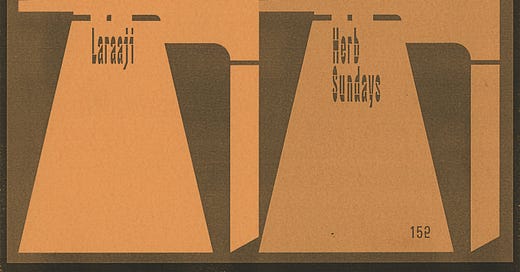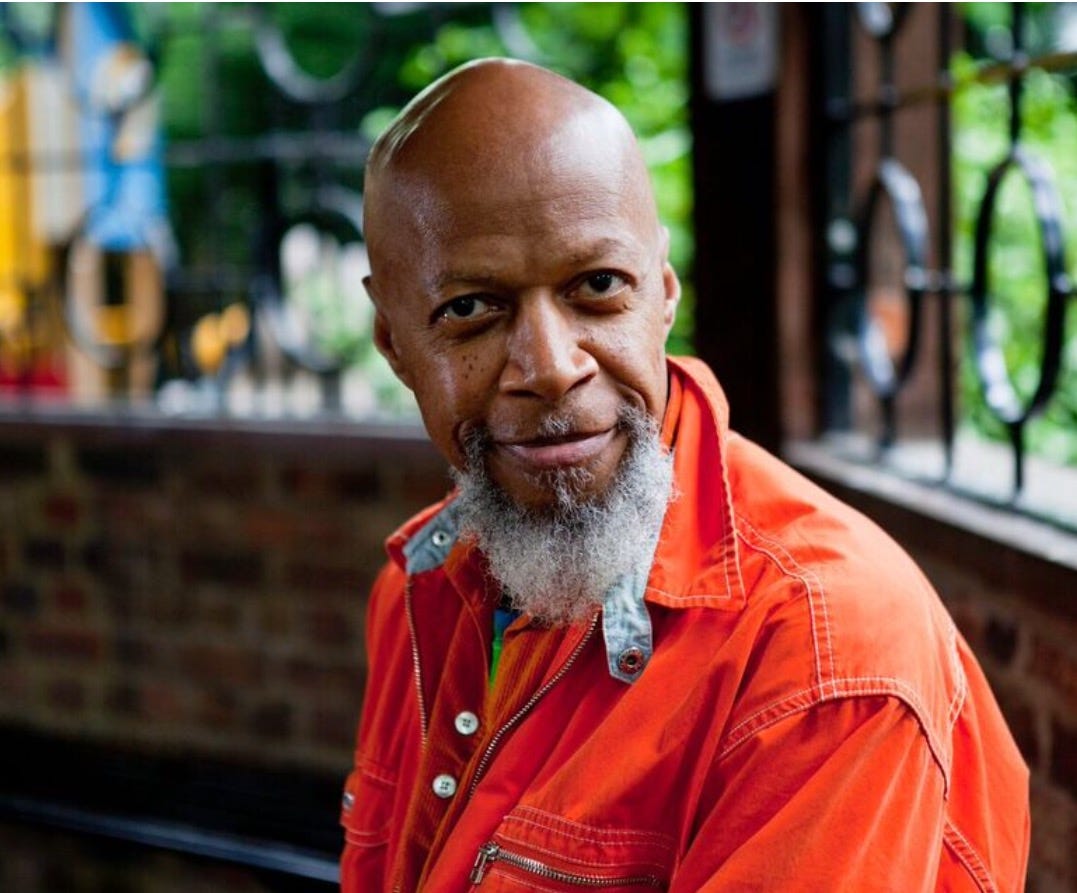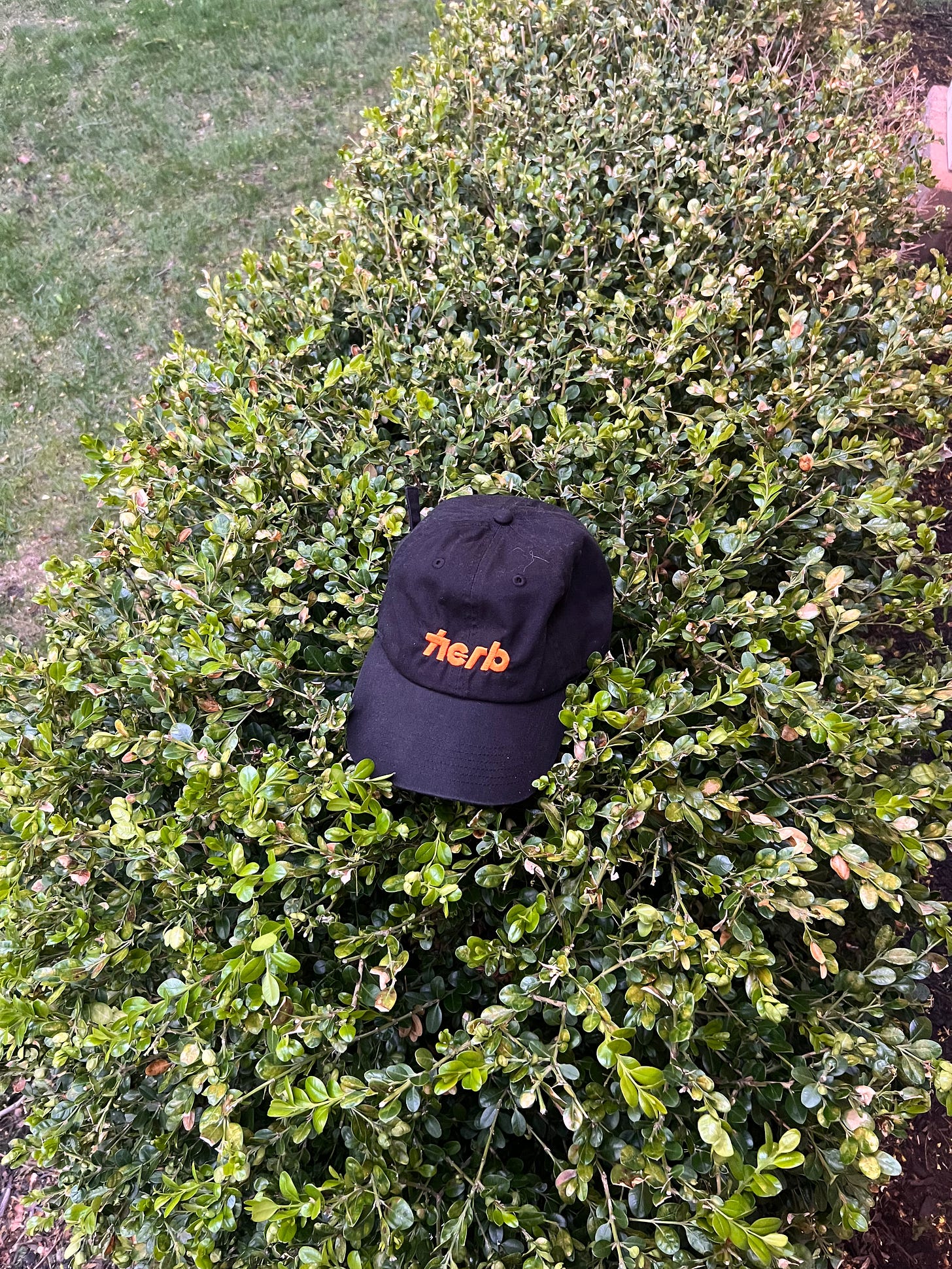Herb Sundays 152: Laraaji
The new age/ambient/experimental icon with music to "be enjoyed at low background volume as one reads, contemplates, dreams, receives, nurtures body work, or gazes into into the beyond."
Herb Sundays 152: Laraaji
Playlist: Apple Music, Spotify. Art by Michael Cina
Physical: Buy Laraaji vinyl and more from our friends at Numero Group. Herb readers get 25% off his oeuvre using code: SundaysForLaraaji
“The playlist I’ve submitted may be enjoyed at low background volume as one reads, contemplates, dreams, receives, nurtures body work, or gazes into into the beyond”
- LARAAJI 5.1.25
A lot of Laraaji’s origin story feels like a Silver Age Marvel conceit: A young man, Edward Larry Gordon, with a rapidly expanding consciousness, maybe too cosmic even, backlit in his trademark orange against the backdrop of his beloved New York City under a new alias. In lieu of an intro bio I’ll give
the first word, from her 2023 The New Yorker profile, as is wise:In 1969, Edward Larry Gordon—a standup comedian, part-time jazz pianist, and aspiring actor—walked into a New York City pawnshop, hoping to hock his guitar for rent money. Instead, Gordon found himself preternaturally drawn to an Autoharp, a type of zither popularized in the nineteen-forties by Mother Maybelle, of the Carter Family, and prominent in the folk revival then going on in Greenwich Village. He lugged it back to his apartment in Harlem and started tinkering, eventually prying off the chord bars (which allowed him to more easily experiment with pentatonic, modal, and minor tunings) and adding a contact pickup (which electrified the instrument). Soon, Gordon was playing the Autoharp through effects pedals, and cramming various odds and ends, including chopsticks, mallets, and pedal-steel slides, underneath the strings—a technique popularized, for piano, in the nineteen-thirties, by the experimental composer John Cage. Gordon’s Autoharp no longer sounded dainty or sweet. It was now fierce, glimmery, and extraterrestrial.
The kismet and coincidences keep piling up, hearing Steven Halpern (feat. Iasos) while working at a coffee shop in the mid ‘70s and being switched even further on, finding his orange outfit (he’s been profiled in Vogue for it) in 1979 next to his regular Hare Krishna restaurant in Midtown, and working as a sidewalk performer which led to a lifelong friendship with Brian Eno and yet another pioneering release. But the most comforting bit is his career renaissance in this and the last decade, where the lanes of Ambient and New Age, which Laraaji has been instrumental in, have become native sounds to a new generation. As Simon Reynolds (Herb 32) wrote for Resident Advisor: “He's become a friend and mentor to Matthewdavid [of Leaving Records], who in turn has promoted Laraaji concerts at Highland Park venues such as the Lodge Room. It's quite a trip to see the 75-year-old performer and his partner Arji OceAnanda stroking rippling chimes from their array of zithers and other metallophonic instruments, while hundreds of young people sit reverently on the hall's floor.”
Laraaji's herb bonafides are a given of course and he appears on many Herb playlists, including
’s ENO-spective (Herb 138), ’s immaculate New Age Outsiders, Herb 136 (“Dorothy [Carter] randomly meeting a young Laraaji in Tompkins Square Park in ‘77—were they also synthesizing sights and sounds into a ground-shifting vision that provided a means of transport to another realm, a deeper level of understanding, a pathway to a new age?”) and ’s (Herb 77) and has been given many flowers, but the ever-present dread that threatens to consume our conversations and feeds only necessitates the need for MORE Laraaji, which is short for more laughter, more romance, and more radiance amidst it all.As a bellwether of sacred Sunday music, Laraaji is a smiling face on Herb Mt Rushmore, yes, but its his own proclivities, a full-bodied embrace of all music, the rapture of it, that makes him legend alone in these pages. For as cosmic as Laraaji's public persona and transmissions are, his tastes, as echoed in his The Music That Made in Pitchfork with
(and then backed up with ’s Transmissions podcast interview invokes the many sides of the man: The love lush vocal group harmonies (a style shared with friend Eno), the machine funk of Samantha Fox, and yes even the CVS-ready heat of mid-'80s Heart:Laraaji on “These Dreams”
“That’s one of my favorite pieces. I would hear it in San Francisco while visiting, on somebody’s radio or exuding from a store, and it would cause me to stop and just savor the beauty of the day and feel a luscious sound experience without really understanding what the words were ever saying. The way that the voice flows and the way the music comes together—it had a mesmerizing effect on me.”
How secular but how sacred. Laraaji talks about songs not just as the recording but as specific moments between his consciousness, the art, and the moment, and more importantly, about the pleasure it creates, which makes him a forever inspiration. As
(Herb 54) also rightly testifies, he’s often overlooked as a “consummate New York artist. Yet the city’s cultural evolution of the past 50 years can be gleaned through his story. Somewhat recognizable New York neighborhoods are rich, invisible characters in Laraaji’s narration of music and consciousness expansion.”I had a similar spiritual response at a Ralph’s in Westwood recently when “Never” from the same S/T 1985 Heart album ripped through the flush mount speakers probably 20 feet above and right into my (i think) third eye, I had to text my friend Eli (who loves gated drums more than anyone I know) to affirm to moment. I then went to Discogs (as i do often) to confirm release date for that Heart album and to scroll the comments looking for a similar ecstatic moment (youtube always delivers, as
has written about) and was confronted with this sorta sad thing:…I have a technics 1200G and have tried 4 cartridges Ortofon 2m bronze, Nagaoka MP500 & MP-110, old Stanton 680EL. With two different phono preamps Quick Silver phono / schist Manning. No matter what combination I use I can not get this pressing to sound correct. Base is weak vocals are thin and fair sound stage…
I try not to deride any audio passion, as building a good hi-fi is a noble pursuit but it reminded me, or actually Laraaji reminded me, that music and by extension life itself, is those unexpected moments of clarity, not perfecting a clean lab for art. Laraaji’s message stripped of any coding is that music, however it finds you is more than enough itself, paired with a good walk and romance in your heart, it is everything.

Our parting shot comes from the man himself as interviewed by
for :JMK: I just have one more question for you. We talked a lot about romance and the things you love, stories about people, and your instruments. Can you share one thing you love about yourself?
L: I love that I trust this moment to be my source and my destiny. I trust investing a majority of my resources in this moment. (laughs). I love that I trust this moment. What I mean by that is I trust in being still, being empty, being silent so that the presence of the moment slides up in my awareness. I trust feeling safe here, I trust that this moment will provide me all the information I must have in order to be creative endlessly. I trust that this moment is a place where I can rest, and that this moment is common to everyone else’s inner moment. Through this moment we can go back to our common moment, our common denominator.
Bonus Beats:
Ghostly on Substack, episode one: a newish hope.
Summer is near, cause Nick León (Herb 140) says so. New album in June.
Welcome TOPS to the Ghostly orbit: We as longtime fans, first time callers prepare for heat and madness, pop imperial era revisited.









Laraaji is truly an inspiration. When I think of spiritual music, Laraaji is always top of mind. Truly taps into the tone of the universe. So excited to this.
Omg was not expecting the Heart and Samantha Fox mentions, I'm obsessed